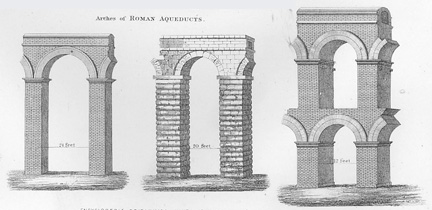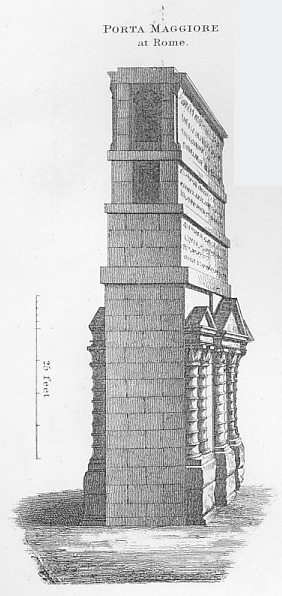1902 Encyclopedia > Aqueduct > Ancient Roman Innovation: Aqueduct Bridges. Aqua Claudia. Anio Novus. Pont du Gard Aqueduct, Nîmes, France.
Aqueduct
(Part 4)
Ancient Roman Innovation: Aqueduct Bridges. Aqua Claudia. Anio Novus. Pont du Gard Aqueduct, Nîmes, France.
If, to obtain a proper incline, the water-course had to be carried above ground, the simple plan was to support it on a stone wall, and in this case the conduit itself was also built of blocks of stone, coated with a stucco impervious to water. But since a solid wall across a valley would have cut off the usual traffic, it was found necessary to break up the wall, by means of arches, into a series of pillars, and with this commenced the system of aqueduct bridges, which have proved to be the most striking monuments of the Roman empire.

Arches of Roman Aqueducts

Porta Maggiore, Rome
As perhaps the best known instance of this double purpose of an archway under which traffic might pass, and over which water might be conveyed, there is the Porta Maggiore at Rome (Plate III.)
The waters conveyed over it in two separate channels, are the AQUA CLAUDIA and the ANIO NOVUS, and from the three inscriptions above the arches it appears – (1.) that the Emperor Claudius had constructed the so-called Aqua Claudia Aqueduct from the springs Caeruleus and Curtius, 45 miles from Rome; (2.) that the same emperor had constructed the so-called Anio Novus Aqueduct from the 62d milestone from Rome; (3.) that the Emperors Vespasian and Titus had restored these splendid undertakings of Claudius. Both aqueducts had been begun by Caligula, 38 A.D., and were completed ten years after by Claudius. The two springs from which the Aqua Claudia took its rise were in the Sabine hills near the 35th milestone, on the Via Sublacensis. It was augmented by part of the Aqua Martia, famous for the goodness of its water, and, owing to bends in the course, reached the length of 45 miles, as stated in the inscription, 35 miles of it being under and 10 above ground.
The Anio Novus, so called to distinguish it from an older aqueduct, the Anio Vetus, took its rise in the river Anio at the 62nd milestone, on the road just named, the water being first collected in a large basin, where it was allowed to purify itself. At the 32d milestone it was augmented by the clearer water of the spring, rivus Herculaneus. The entire length of 62 miles was partly above and partly below ground. About 6 miles from Rome it approached the Aqua Claudia, and from that point the two waters traveled together to the city in two distinct channels, one above the other, and supported by a chain of arches, which at one place reached the height of 109 feet.

Pont du Gard, Nîmes, France
But in height these arches must yield to those of the aqueduct at Nismes [Nîmes, France], the ancient Nemausus, erected in the time of Augustus, which rose to 180 feet. The Pont du Gard, as the aqueduct at Nismes [Nîmes] is now called, consists, as will be seen from Plate IV., of three rows of arches striding across the valley of the river Gardon. In the lowermost row are six arches, of which one has a span of 75 feet, the others each 60 feet. In the second row are twelve arches, each with a span of 75 feet. In the third tow are thirty-six smaller arches, immediately above which was the water-course. As a bridge, the Pont du Gard has no rival for lightness and boldness of design among the existing remains of works of this class carried out in Roman times.
Read the rest of this article:
Aqueduct - Table of Contents
|


